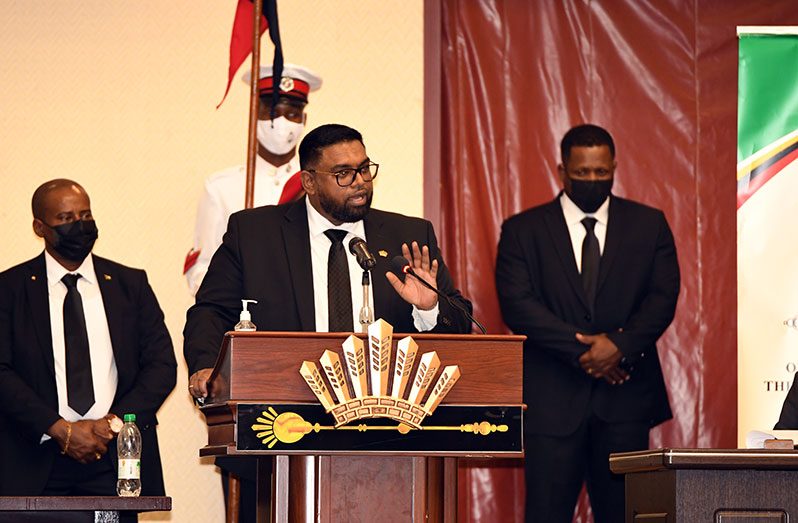–as authorities push ahead with creation of ‘world-class’ energy mix
–plans afoot to form energy corridor with Brazil and Suriname
DRIVEN by an energy mix of solar, wind, hydro and natural gas, Guyana could soon become a major player in the energy market, and ultimately the energy capital of the Region, President Dr. Irfaan Ali has said.
According to the United Nations Development Programme (UNDP), access to modern energy services is fundamental to fulfilling basic social needs, driving economic growth and fuelling human development. This is because energy services have an effect on productivity, health, education, safe water and communication services.
For developing nations such as Guyana, the need for reliable and affordable energy is more fundamental. The general understanding is that reliable energy, in these countries, supports expanded industry, modern agriculture, increased trade and improved transportation.
In Guyana’s context, “energy security,” as said by President Ali during his inaugural address to the 12th Parliament, will be driven by an energy mix that will see solar, wind, hydro and natural gas being utilised to make this nation the energy capital of the Region.
The integration of those energy sources will provide Guyana with 400 megawatts of newly installed power. As it is now, the national grid is providing 120 megawatts of electricity, an amount which is equal to the consumer demand of 117-120 megawatts of power.
Based on what the President has outlined, the potential “world-class” energy mix will not just increase Guyana’s energy capacity, but will also significantly reduce the cost of electricity for households and businesses.
The overarching aim of the new People’s Progressive Party/Civic (PPP/C) government is to reduce the overall cost of energy by 50 per cent through this energy mix.
Local capacity aside, President Ali is confident that the government’s plan will make Guyana’s energy costs globally competitive.
Essentially, the country could become a net energy exporter. A net exporter is a country or territory whose value of exported goods is higher than its value of imported goods over a given period of time.
“Our potential to become a major player in the energy market is not only limited to our borders, but we have already commenced discussions with our neighbours, Brazil and Suriname, in the establishment of an energy corridor,” President Ali said.
International experts say that energy corridors may accommodate multiple pipelines for oil, gas, or hydrogen, electricity transmission lines, and related infrastructure, such as access and maintenance roads, compressors, pumping stations, and other structures.
PHYSICAL LINKAGE
Guyana is already closer to building a physical linkage with Suriname through the construction of a bridge across the Corentyne River. The Lethem to Linden road is also on the cards.
Those physical linkages will pave the way for increased cooperation, especially now that Guyana and Suriname have joined Brazil in the ranks of oil-producing nations.
Locally, the government has already indicated its intention to utilise natural gas from its oil-and-gas-sector to produce power at cheaper rates. It was reported that the price paid by Guyana for kilowatt per hour of electricity could be reduced by about 80 per cent when the proposed gas-to-energy project comes on stream.
The cost factor associated with this project has, however, been a topic for discussion in the public domain. But Vice-President Jagdeo believes that the overarching benefits of this project outweigh any cost associated with establishing the facilities.
“It could be from US$500 million- US$800 million to develop the pipeline, depending on the design, geo-technical study and so on… when we go out to tender that is the only time we will know the actual cost,” Vice-President Bharrat Jagdeo said during a press briefing at the Arthur Chung Conference Centre on Tuesday.
Another US$300 million is estimated to be spent on the construction of a power plant, but again, a definitive cost will only be ascertained when the government goes to tender.
“We are working through the numbers… remember we are still in the preparatory stages, so a lot of these are estimates, but those are the magnitude of the types of estimates… one man said it is not feasible, but how can you determine it is not feasible when you have not done a feasibility study,” the vice-president reasoned.
In his view, with power being generated at six cents per kilowatt hour — about 80 per cent less than the current US$30 cents per kilowatt hour — the average Guyanese and the private sector would surely benefit.
“It is a no-brainer, the benefits are enormous… the gas is also less polluting than diesel,” Jagdeo said, noting that definitive projections will soon be available as the government is in the process of hiring people to conduct four sets of studies.
The studies will not only determine the feasibility of the project, but it will also assess the proposed location for the project, which is likely to be Wales on the West Bank of Demerara (WBD).




.png)









